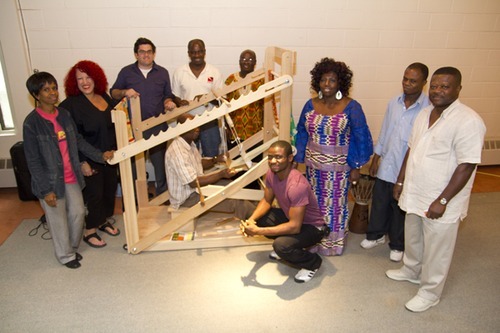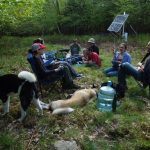Con Edison Immigrant Artist Program Newsletter, Issue No. 32
Featured Organization: Council on the Arts & Humanities for Staten Island (COAHSI)
This month we’re pleased to feature the Council on the Arts & Humanities for Staten Island (COAHSI) and highlight its dedication to supporting the folk arts on Staten Island, which are a vital part of its cultural fabric. COAHSI sees that the appreciation of these time-honored traditions is essential for recently-arrived Staten Islanders to engage with their neighbors and pave a way for a new life while building trust and respect for their identity and presence in the diverse cultural landscape of the island.
Through the means of close collaboration with artists, community leaders and social service organizations, COAHSI works to accomplish their mission of making the arts accessible to everyone and providing artists and organizations with the technical, financial and social resources they need. NYFA Program Associate Michon Ashmore interviewed Christopher Mulé, Deputy Director & Director of Folklife of COAHSI about the organizations programs, challenges, and its plans for the future.
IAP: COAHSI provides the traditional artists of Staten Island with the technical and financial assistance they need to sustain and cultivate the growth of their folkways. What specific programs do you have in place to foster the work of these artists? What effect has COAHSI’s Folk Arts program had on Staten Island’s folk arts since its inception?
COAHSI: The process of organizing public exhibitions and programs has been an important part of cultivating folklife on Staten Island. COAHSI, the island’s regional and county folklorist, funds four public programs per year. These public programs and the process of creating them energize the folk arts within communities and highlight the importance of tradition. On Staten Island, this is extremely important because Staten Island’s ethnic diversity has increased rapidly over the past 20 years. Recently, the North Shore community of Port Richmond has witnessed close to a dozen hate crimes toward its Mexican residents. There was also widely publicized opposition and protest of a mosque being established in a vacant Roman Catholic church. No matter where you stand on the issue, this can cause traditional folk arts practitioners in immigrant communities to become insular.
For fear of insularity, we started a project last year called “The Culture of Joy & Resilience: Reframing Cultural Conversations on Staten Island.” The goal was to have public programs and traveling exhibits across the island that introduced Staten Island to its own diversity, through art. We wanted to change the conversation on Staten Island so that people would talk about the cultural enrichment that immigrant communities bring to the table. We selected four traditional arts practices (Mexican dance, Kente Cloth weaving, traditional Irish music and dance, and Liberian dance and drum) and brought them to public libraries across the island. In the end, I think the program fostered a sense of trust between COAHSI and the folk artists and immigrant communities on Staten Island. We created and encouraged a safe space for folk artists to explore and present their heritage.
IAP: What particular challenges do Staten Island’s traditional artists face, with many of them being part of immigrant communities? What are their specific needs?
COAHSI: A lack of available time to devote to artistic practices is probably the greatest challenge for traditional arts on the island. Some of the artists I work with work close to seven days a week and hold down several jobs and responsibilities. Language barriers are also a problem, particularly when working with immigrant communities that have a wide variety of dialects. This occurs on Staten Island within the Mexican and Liberian communities – both have many different dialects. We also have a lack of accessible and affordable venues for public programs and rehearsals. Finally, there seems to be a low value on and inability to embrace diversity on Staten Island. Many times we talk about amplifying voices of underserved communities, but I think they are already pretty loud. I think many other Staten Islanders do not listen, and that makes the success of diverse expressions more difficult.
IAP: All of your folk arts projects are developed through close collaboration with local community leaders and social service organizations, as well as the artists themselves. How did this approach evolve and how do these partnerships benefit the programs?
COAHSI: It is important that projects with traditional communities are undertaken with close community collaboration. When I first started my post here as the regional and county folklorist I tried to meet as many folks as I could and find out who was who and what organizations people in the communities were comfortable with. Social service organizations and community leaders tend to be trusted sources of information and activities within immigrant communities. Building trust within immigrant communities is of the utmost importance to the success (and sustainability) of Staten Island folk arts. I am still building those relationships. Some of the communities, particularly the Liberian community on Staten Island, feel that they have been exploited by outsiders doing research, writing stories, or making films about their plight. Many of those projects failed to give back to the community and failed to accurately explain who they are. I want to make sure that all folk arts collaborations benefit the community from which they came. It is also important to find the right community leaders who understand traditional values. I am currently working with a great group of them: Zeinab Eyega and Admah Fassah in the Liberian community, and David Suarez, Victor Soto, and Emma Tapia in the Mexican community of Port Richmond. Many of these artists are now becoming leaders of their community’s traditional arts activities. Having the communities own their expressions and the programs that display them helps immensely and adds to the likelihood that traditions will be continued. I try my hardest to let them know that they are the pilots and I am just part of the ground crew.
IAP: One goal of COAHSI’s Folk Arts program is to provide meaningful experiences for folk artists while also engaging a wider audience and making folk arts accessible to everyone in the community. What specific approaches do you take in reaching this goal? What responses have you received from general audiences?
COAHSI: This is one of the hardest things to do. A meaningful experience for the traditional artists and the communities that cultivate those traditions is my biggest concern, at the moment. I think the process leading up to public exhibitions of traditional arts is a great learning experience for artists. We work hard, spending months on dialogue and fieldwork, and the artists end up teaching me about their customs so I can better understand them. Hopefully, by the time we are ready to present traditions to the public, the artists are in charge and I fade to the background.
I also have learned that meaning comes from community-based traditions involving the whole community. We recently presented a program about Oaxacan poems and songs with musicians from Port Richmond and artists from Sierra Leone in Park Hill. In both instances, many people in the community were involved. It was hard to tell the difference between the audience and the performers. These artistic expressions generate a lot of pride and that helps to make things meaningful.
Generating general audience engagement on Staten Island is a learning process and one that I am still involved in. The more established audience on Staten Island seems interested in learning more about new immigrant communities but it is difficult to get them to come to events. I provide interpretive materials (programs) at each event, translation, and try to find venues that are comfortable for everyone. These public displays are more than “programs” for entertainment-I see them as offerings and opportunities to increase Staten Island’s cultural capital. A famous folklorist named Henry Glassie wrote that art provides “a culture’s most radiant and integrated expressions of its values.” It has been a challenge to reach out to wider audiences but I am trying hard to emphasize that these programs are not just for the immigrant communities, as they contribute to the health and cultural wealth of our borough.
IAP: What future plans do you have for the program?
COAHSI: As mentioned, venues can be very hard to access on Staten Island. This year we will bring the arts to the audience through our Mobile Heritage Project. We will set up stages at several outdoor spaces where people tend to congregate – the boardwalk at South Beach, the farmers market in the Staten Island Mall parking lot, etc. We are looking to maximize exposure for our traditional artists on the island. In a way, we are going to “Occupy” Staten Island with folk arts!
This winter I am collaborating with an organization called Sauti Yetu to document traditional folktales of the women within the Liberian community in Park Hill. Looking towards a sustainable future, I am also working with a professor at Pratt Institute’s School of Information Science to develop an online portal that will enable traditional artists and communities to build a digital archive of Staten Island traditional arts.
IAP: How can people get involved with COAHSI and its Folk Arts program?
COAHSI: I am always looking for people to help me with some of our folklife programs. If you are interested in learning about documenting cultural traditions, organizing events, or building an archive, please contact me at the following email address:[email protected]. I promise that you will get a very interesting introduction to Staten Island. In addition, you can check out our folklife blog here and sign up to our email newsletter. COAHSI is very lucky to have our Executive Director, Melanie Cohn, at the helm and a very talented, passionate, and professional staff that works extremely hard to keep the arts on Staten Island driving forward. If you have never been to Staten Island, I suggest coming to one of our programs and letting us introduce you to the arts and humanities that this borough has to offer.





